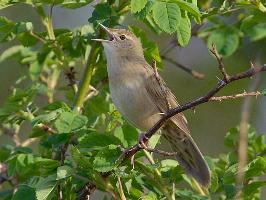
Description de l'animal
The River Warbler (Locustella fluviatilis) is a fascinating and somewhat elusive songbird that belongs to the Locustellidae family, which is known for its members' skulking habits and distinctive vocalizations. This small bird, with its relatively plain appearance, might not catch the eye at first glance, but its vocal prowess and intriguing behaviors make it a subject of interest among bird enthusiasts and ornithologists.Physical Characteristics:
The River Warbler is a small-sized bird, measuring about 13 to 15 centimeters in length and weighing around 15 to 22 grams. It exhibits a rather inconspicuous plumage, primarily characterized by a blend of olive-brown and gray colors on its upper parts, which helps it blend seamlessly into its natural habitat. The underparts are paler, often described as off-white or light beige, with fine, dark streaks that provide a subtle contrast. Its legs are a pinkish or flesh color, and it has a relatively short, fine bill typical of insectivorous birds. One of the distinguishing features of the River Warbler is its faint supercilium (eyebrow-like line) that stands out against its otherwise plain face.
Habitat and Distribution:
The River Warbler is a migratory species that breeds across parts of Eastern and Central Europe, extending into the western parts of Russia. Its breeding habitat is predominantly damp, dense undergrowth in deciduous forests, often near water bodies like rivers or swamps, which is reflective of its name. After the breeding season, these birds embark on a long migration journey to sub-Saharan Africa, where they spend the winter in savannahs or lightly wooded areas, demonstrating a remarkable adaptability to different environments.
Behavior and Diet:
River Warblers are known for their skulking behavior, often staying hidden within thick vegetation, which makes them more often heard than seen. They are primarily insectivorous, feeding on a variety of insects and other small invertebrates. Their foraging technique involves gleaning prey from leaves and branches, sometimes catching insects in mid-air with a dexterous aerial maneuver.
Vocalization:
One of the most remarkable aspects of the River Warbler is its song. The males are known for their continuous, trilling song that can last for several minutes without interruption, a characteristic that is not only used to attract mates but also to assert territory. This song is a distinctive feature, often likened to the sound of a sewing machine, and can be heard during the breeding season, usually from a concealed perch within thick vegetation.
Conservation Status:
As of my last knowledge update in 2023, the River Warbler is classified as Least Concern by the International Union for Conservation of Nature (IUCN), indicating that it is not currently at immediate risk of widespread decline. However, like many migratory species, it faces threats from habitat destruction both in its breeding and wintering grounds, making habitat preservation efforts crucial for its continued survival.
In conclusion, the River Warbler may not be the most visually striking bird, but its unique song, intriguing behaviors, and the mysteries surrounding its skulking lifestyle make it a captivating species for those interested in the natural world. Despite its elusive nature, ongoing research and conservation efforts continue to unveil the secrets of this remarkable bird, ensuring its song continues to resonate across its vast migratory range.
Animaux similaires
Nouvelles photos d'animaux
Top 10 des animaux
- Dolphin gull (Leucophaeus scoresbii)
- Diana monkey (Cercopithecus diana)
- Moustached guenon (Cercopithecus cephus)
- Galápagos tortoise (Geochelone nigra complex)
- Russian tortoise (Testudo horsfieldii)
- Japanese macaque (Macaca fuscata)
- Stone loach (Barbatula barbatula)
- Greek tortoise (Testudo graeca)
- Common flying dragon (Draco volans)
- Colossal squid (Mesonychoteuthis hamiltoni)
